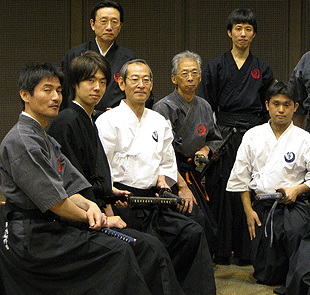IAIDO
Practice Iaido in Japan - our selection of clubs
IAIDO or IAI JUTSU according to whether one seeks fluidity, aesthetics and self-esteem, or more accuracy and martial efficiency, is art of the Japanese sword, major discipline of the samurai of the past: the art of unsheathing the sword and cut at the same instant.
Art of spontaneous and natural gesture, it is a discipline that is practiced alone, face to oneself, in the form of kata (codified movements).
Around the practice of the samurai sword were two types of complementary koryu (old schools), ken-jutsu or saber-handling techniques, and iai-jutsu, techniques of slicing by unsheathing.
The iai was codified at the end of the 16th century by Hayashizaki Jinsuke, and quickly spread through traditional schools.
The 4 main phases:
NUKI TSUKE: the stripping
KIRI TSUKE: the main cut
CHIBURI: cleaning the blade
NÔTO: sheathing
TOKYO nihonbashi
Suimokai is an organization dedicated to the study and dissemination of traditional Japanese martial arts, especially the Mugairyu Meishi Branch (iai, kenjutsu, kumitachi, Shizan), Shindomusoryu Jo and Uchidaryu / Toseiryu Tanjo.
The chief instructor of Suimokai is the founder of the Meishi Branch, Gyokudo Toyoaki Niina. He was a student of Hosho Shiokawa, himself a student of Shiryu Nakagawa.
Niina-gosoke is Hanshi, Menkyo-kaiden in Mugairyu Iaihyodo, Shindomusoryu Jodo and Uchidaryu Tanjojutsu.
Their practice is effective techniques by katas solo, partner practice by kumitachi, and the trial cut, both long and short sword.
EMAIL CONTACT
KYOTO
Kyoto Hokenkai belongs to the Japan Kendo Federation and the Kyoto Kendo Federation.
The members of this club practice mainly what is called the Seitei Iai composed of 12 kata, and at the same time the traditional Koryu Ia of the school Musô Jikiden Eishinryu gathering about 50 kata.
This is a large club that practices in a dozen dojo including the Kyoto Budo Center, at the famous Butokuden dojo, three times a week:
Tuesday, Thursday and Friday
from 18.30 - 20.15
KYOTO
Club is also part of the National Federation of Kendo, members practice Seitei Iai and Koryu Iai.
Dojo's adress : 3-2, Takagishi-cho Sikagaya, Sakyo-ku Kyoto-shi, Le Sakyo Tobu Ikiiki simin Katsudo Center 3F.
Dojo is inside the Shinto shrine of Heian jingu.
Classes on Wednesday 18h-21h.
TOKYO shiyoda
IAIDO & KENJUSTSU
An association active mainly in Tokyo through Iaido and Kenjutsu training, and thereby fight for the popularization of ancient Japanese martial arts.
Gettan Tuzi sensei founded the Mugai Ryu 400 years ago.
Sensei Mitsuyoshi SEKIDO.
CONTATC EMAIL
videos
https://www.mugairyu.jp/myo/index.html
OSAKA - KYOTO
Shinbukan is part of the National Federation of Iaido.
Only Koryu Iai, a traditional Yai of the Musô Jikiden Eishinryu school, is practiced, the club is mainly active in Hirakata, north of Osaka.
Kyoto Dojo's address:
149 Tanakagenkyo-cho Sakyo-ku Kyoto-shi.
Classrd: Wednesday 10-13h,
Sunday 10-13h twice a month.
TOKYO shinjuku
The sensei is a woman, Michiko MORITA, 3th dan.
Present in Australia and USA.
KYOTO
"Visitors" classes at the gymn, room n°1.
Monday 15:00-16h30
Tuesday 15:00-16h30
Thursday 15h00-16h30
Friday 15:00-16h30







